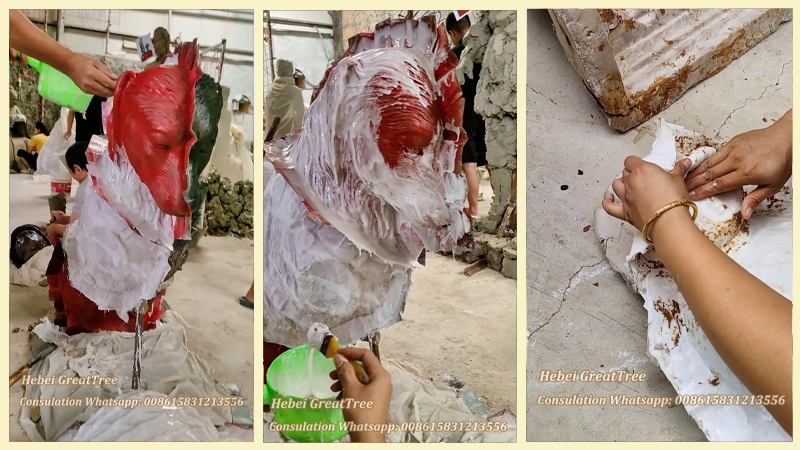The mold turning step in the bronze sculpture production process is mainly divided into the following steps:
1. Collect materials, and the sculpture craftsman will use sculpture clay to make a 1:1 clay sculpture. The clay sculpture will be enlarged and shaped in equal proportions. Each piece will take about a month from shaping to trimming.
2. Determine the reproduction method according to the complexity of the bronze sculpture. Simple bronze sculptures can be made from plaster, while more complex ones can be made from silicone. If it is made from plaster, you need to spray soapy water or detergent water twice on the clay sculpture, and then start pouring plaster on it. It will be thinner at first and gradually become thicker. After two coats, add rice dumplings and finally fix it with a stick.
If it is made from silicone, you need to apply mold silicone layer by layer on the surface of the clay sculpture. Each time, apply the next layer until it is half dry. After applying it about 3 times, fill in the undulating areas to create a chaotic appearance. The chaotic circle is mainly for easy parting in the next step.
Further description of silicone mold making below:
1. Mold design: Before making a silicone mold, the mold needs to be designed according to the requirements of the bronze sculpture work. Including the shape, size, structure, material and other considerations of the mold to ensure that the mold can produce bronze sculptures that meet the requirements.
2. Prepare mold materials: Prepare appropriate silicone materials and tools according to the requirements of the mold design. For example, select the appropriate amount of silicone raw materials according to the size and shape of the mold, and prepare tools such as stirrers, brushes, and scrapers.
3. Prepare silica gel: Add catalyst, filler and other auxiliary materials to the silicone raw material according to a certain proportion, stir evenly with a stirrer, and prepare suitable silica gel. It should be noted that the types and amounts of catalysts and fillers should be selected and adjusted according to the characteristics of the raw materials and production requirements.
4. Paint the mold: Apply the prepared silicone evenly on the inner wall of the mold with a brush to ensure the coating thickness is appropriate and the surface is smooth. After the painting is completed, place the mold in a ventilated and dry place and wait for the silicone to gradually solidify.
5. Make the mold structure: During the solidification process of silicone, the structure of the mold can be made according to the requirements of the mold design. For example, materials such as wood blocks and foam can be added to the silicone to increase the strength and stability of the mold.
6. Mold disassembly and trimming: After the silicone is completely solidified, disassemble the mold and trim the mold surface to ensure that the surface is smooth and flat. Any defects or deficiencies can be supplemented or repaired to ensure the quality of the bronze sculptures.
7. Drying and storage: Store the silicone mold in a dry, cool environment for subsequent use. At the same time, attention needs to be paid to avoid the impact of direct sunlight and humid environment on the mold to avoid damage or deterioration of the mold.
In the process of making bronze sculptures, silicone mold making is a very important step, and its quality directly affects the quality and beauty of the bronze sculptures. Therefore, when making silicone molds, each step needs to be performed carefully and carefully to ensure the quality and safety of each step. At the same time, it is also necessary to constantly summarize experience and technology and improve production skills and levels to produce more exquisite and high-quality bronze sculptures.


